Making your fingers stretch for guitar involves specific exercises and techniques, and at guitarplayers.net, we understand the importance of flexibility for guitarists. These stretches improve your reach and dexterity, enabling you to play complex chords and solos with greater ease and comfort. Strengthening your hand muscles, improving finger independence, and enhancing your overall guitar playing experience are all possible by consistently incorporating these exercises into your routine.
1. Understanding the Importance of Finger Stretches for Guitarists
Finger stretches are crucial for guitarists of all levels because they improve flexibility, prevent injuries, and enhance playing ability. Stretching keeps your hands and fingers limber, which allows you to reach wider intervals on the fretboard.
1.1. Why Finger Flexibility Matters
Finger flexibility is essential for guitarists for several reasons:
- Improved Reach: Greater flexibility means you can comfortably reach wider intervals on the fretboard.
- Reduced Risk of Injury: Stretching helps prevent strains and conditions like carpal tunnel syndrome.
- Enhanced Dexterity: Flexible fingers allow for more precise and intricate playing.
- Increased Comfort: Stretching reduces tension, making longer practice sessions more enjoyable.
- Better Technique: Finger flexibility supports proper hand positioning and technique, leading to cleaner and more efficient playing.
1.2. Common Challenges Guitarists Face
Guitarists often face challenges related to finger flexibility, such as:
- Limited Reach: Inability to play chords or scales that require wide finger spacing.
- Stiffness: Fingers feeling tight and restricted, especially after long periods of inactivity.
- Pain and Discomfort: Experiencing pain in the hands, wrists, or fingers while playing.
- Inability to Play Certain Techniques: Difficulty with techniques like fingerpicking or playing complex chord voicings.
- Slow Progress: Hindered skill development due to physical limitations in finger flexibility.
1.3. Benefits of Regular Stretching
Regular finger stretching provides numerous benefits for guitarists:
- Injury Prevention: Stretching reduces the risk of strains, sprains, and overuse injuries.
- Increased Range of Motion: Stretching allows your fingers to move more freely and cover greater distances on the fretboard.
- Improved Circulation: Stretching promotes blood flow to the hands and fingers, which can help reduce stiffness and soreness.
- Enhanced Muscle Recovery: Stretching helps to speed up the recovery process after intense practice sessions or performances.
- Overall Performance Improvement: Regular stretching contributes to better technique, increased speed, and greater accuracy in playing.
2. Essential Finger Stretching Exercises Without a Guitar
Before picking up your guitar, warming up your fingers with targeted stretches is crucial. These exercises enhance flexibility and prepare your hands for playing.
2.1. Individual Finger Stretches Using a Table Edge
Target each finger individually using a table or desk edge to improve joint flexibility.
- Placement: Place the tip of one finger on the edge of the table or desk, keeping it straight and aligned with the surface.
- Push Down: Gently push down, bending your finger back until you feel a stretch.
- Hold: Hold the stretch for about 15-20 seconds.
- Repetition: Repeat this exercise for each finger, including the thumb.
- Finger Position: Keep other fingers closed against your palm to encourage finger independence.
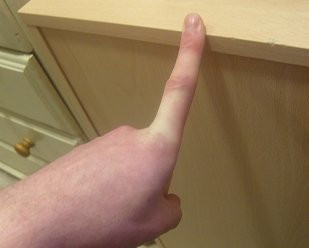 Stretching the index finger against a desk
Stretching the index finger against a desk
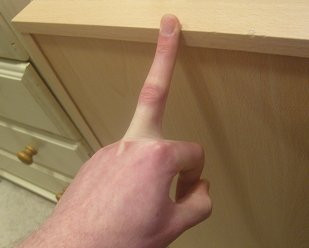 Stretching the middle finger against a table
Stretching the middle finger against a table
2.2. Thumb Stretching Techniques
The thumb is crucial for gripping the guitar neck, so stretching it is essential, especially for fingerstyle players.
- Thumbs Up: Give a thumbs-up and gently pull your thumb to the side with your other hand.
- Hold: Hold the stretch for 15-20 seconds.
- Finger Movement: While holding the thumb, open and close your other fingers to increase the stretch.
- Wall Stretch: Alternatively, use a wall or the palm of your other hand as a “wall” to push against.
- Repetition: Repeat this stretch multiple times.
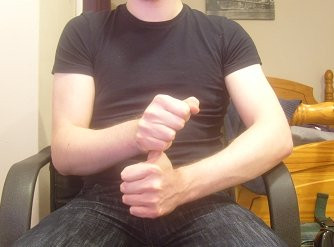 Thumb stretching exercise
Thumb stretching exercise
2.3. Wall Stretches for Finger Extension
Wall stretches can help extend your fingers and improve their individual strength.
- Positioning: Stand facing a wall and point to it with one finger, keeping the rest clenched against your palm.
- Push Forward: Slowly push your hand towards the wall, keeping the finger straight.
- Hold: Hold the stretch for 15-20 seconds, feeling the stretch in your finger.
- Repetition: Repeat with each finger.
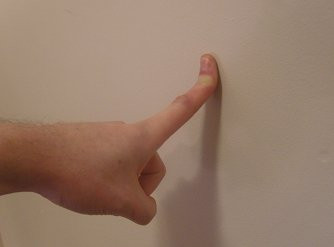 Index finger stretched against a wall
Index finger stretched against a wall
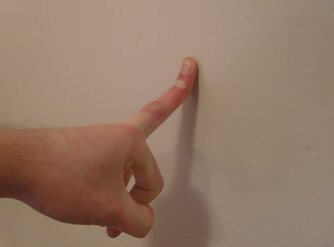 Middle finger wall stretching exercises
Middle finger wall stretching exercises
2.4. Hand Clenching and Unclenching
Clenching and unclenching your hand can help improve circulation and flexibility.
- Extend Fingers: Start by stretching all your fingers together by pushing them back with the palm of your other hand.
- Clench Fist: Slowly clench your hand into a fist, gradually tightening it.
- Hold Briefly: Hold the fist tightly for a few seconds.
- Unclench: Slowly unclench your fist, releasing the tension.
- Repetition: Repeat this clenching and unclenching motion about 10 times.
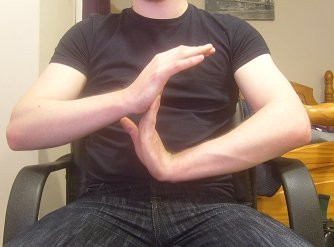 Pushing the fingers back with hand
Pushing the fingers back with hand
3. Incorporating Guitar Neck Stretches into Your Routine
Using the guitar neck for stretching is a great way to prepare your fingers specifically for playing. These exercises help increase the distance between your fingers and get them ready for chord shapes and scales.
3.1. V-Shape Stretches on the Guitar Neck
This exercise uses the guitar neck to stretch the fingers by creating a V shape between them.
- V-Shape: Create a V shape between two fingers.
- Neck Placement: Lodge the guitar neck between them, gently pushing the fingers apart.
- Support: Hold the top of the neck to avoid putting too much pressure on it.
- Stretch: Gently push against the neck to stretch out your fingers.
- Duration: Do this for each finger pairing for about 2 minutes.
3.2. Finger Extension Exercises on the Fretboard
Extending your fingers on the fretboard can improve your reach and dexterity.
- Starting Position: Place your index finger on the first fret of the low E string.
- Extension: Extend your middle, ring, and pinky fingers to reach subsequent frets (2nd, 3rd, and 4th frets).
- Hold: Hold the stretch for a few seconds, ensuring each finger is pressing down firmly.
- Repetition: Repeat this exercise up and down the fretboard.
3.3. Chromatic Scale Stretches
Chromatic scale stretches are excellent for developing finger independence and flexibility.
- Starting Position: Place your index finger on the first fret of any string.
- Chromatic Progression: Use each finger to play consecutive frets (1st, 2nd, 3rd, 4th).
- Ascending/Descending: Play the chromatic scale ascending and descending, focusing on clear and even notes.
- Repetition: Practice this exercise on all strings to build overall finger strength and flexibility.
4. Practical Guitar Exercises to Improve Finger Reach
After initial stretches, incorporating specific guitar exercises will further enhance your finger reach and dexterity.
4.1. Spider Walk Exercise
The spider walk exercise is highly effective for improving finger independence and stretch.
- Starting Position: Place your index finger on the 5th fret of the low E string.
- Finger Placement: Place your middle finger on the 6th fret, ring finger on the 7th fret, and pinky on the 8th fret.
- Lateral Movement: Move up one string and maintain the same finger spacing (index on 5th, middle on 6th, etc.).
- Ascending/Descending: Continue moving across all six strings, then reverse direction.
- Repetition: Repeat this exercise several times, focusing on accuracy and evenness.
4.2. Four-Fret Span Exercises
These exercises focus on stretching your fingers to cover a four-fret span, which is essential for many chords and scales.
- Starting Position: Place your index finger on the 5th fret of the low E string.
- Finger Extension: Extend your pinky to reach the 8th fret of the same string.
- Alternating Fingers: Practice alternating between your index and pinky fingers, ensuring each note is clear and precise.
- String Variation: Repeat this exercise on all six strings to build overall finger strength and flexibility.
4.3. Chord Voicing Exercises for Stretch
Chord voicing exercises involve playing chords with wider finger spacing to improve stretch.
- Open Chords: Start with open chords like C, G, and D.
- Extended Voicings: Experiment with extended voicings that require wider finger stretches.
- Example: Try playing a Cmaj7 chord (x32000) and then move your pinky to the 5th fret of the G string to play a Cmaj9 (x32030).
- Chord Progressions: Incorporate these voicings into chord progressions to make the exercises more musical and engaging.
5. The Role of Hand Posture and Guitar Positioning
Proper hand posture and guitar positioning are crucial for preventing injuries and improving finger flexibility.
5.1. Optimal Hand and Wrist Positioning
Maintaining the right hand and wrist position is vital for playing comfortably and efficiently.
- Relaxed Wrist: Keep your wrist relaxed and avoid bending it excessively.
- Natural Curve: Maintain a natural curve in your fingers.
- Thumb Placement: Position your thumb on the back of the neck for support, but avoid squeezing too tightly.
- Avoid Tension: Be aware of any tension in your hand or wrist and consciously relax your muscles.
- Regular Breaks: Take regular breaks to stretch and rest your hands.
5.2. Adjusting Guitar Height and Angle
The height and angle of your guitar can significantly impact your hand posture and finger reach.
- Sitting Position: When sitting, use a footstool or guitar support to raise the guitar to a comfortable height.
- Standing Position: When standing, adjust your guitar strap so that the guitar sits at a similar height as when you are sitting.
- Angle Adjustment: Experiment with different guitar angles to find a position that allows for optimal hand and wrist alignment.
5.3. The Impact of Poor Posture on Finger Flexibility
Poor posture can negatively affect your finger flexibility and increase the risk of injury.
- Limited Reach: Slouching or hunching over can restrict your reach and make it harder to play complex chords or scales.
- Increased Tension: Poor posture can lead to increased tension in your hands, wrists, and shoulders, reducing flexibility and causing discomfort.
- Long-Term Issues: Over time, poor posture can contribute to chronic pain and musculoskeletal problems.
- Solution: Focus on maintaining a straight back, relaxed shoulders, and a comfortable playing position to support optimal finger flexibility.
6. Incorporating Warm-Up and Cool-Down Routines
Warming up before playing and cooling down afterward are essential for maintaining finger flexibility and preventing injuries.
6.1. Pre-Play Warm-Up Exercises
Warming up prepares your hands and fingers for the demands of playing.
- Light Stretching: Perform light stretches, such as finger extensions and wrist rotations.
- Scales: Play simple scales to get your fingers moving.
- Chromatic Exercises: Practice chromatic exercises to improve finger independence.
- Chord Transitions: Work on smooth chord transitions to warm up your fretting hand.
- Duration: Spend at least 5-10 minutes warming up before each practice session or performance.
6.2. Post-Play Cool-Down Stretches
Cooling down helps reduce tension and promote recovery after playing.
- Gentle Stretches: Perform gentle stretches similar to your warm-up routine.
- Massage: Gently massage your hands, wrists, and forearms to relieve tension.
- Relaxation Techniques: Incorporate relaxation techniques like deep breathing to reduce stress and promote recovery.
- Duration: Spend at least 5-10 minutes cooling down after each practice session or performance.
6.3. The Importance of Gradual Intensity
Gradually increasing and decreasing the intensity of your playing sessions is crucial for preventing injuries.
- Start Slowly: Begin each practice session with slow, deliberate exercises.
- Increase Speed: Gradually increase the speed and complexity of your playing as you warm up.
- Avoid Overexertion: Avoid pushing yourself too hard, especially when you are tired or sore.
- Cool Down Gradually: As you cool down, gradually decrease the intensity of your playing until you are performing gentle stretches.
- Listen to Your Body: Pay attention to any pain or discomfort and adjust your playing accordingly.
7. Advanced Techniques for Enhancing Finger Dexterity
For guitarists seeking to further improve their finger dexterity, advanced techniques can provide significant benefits.
7.1. Finger Independence Training
Finger independence is the ability to move each finger independently, which is essential for complex playing.
- One-Finger Exercises: Practice exercises that focus on moving one finger while keeping the others still.
- Hammer-Ons and Pull-Offs: Use hammer-ons and pull-offs to develop finger strength and independence.
- Alternate Picking: Work on alternate picking exercises to improve coordination between your picking hand and fretting hand.
- Chromatic Scales: Practice chromatic scales with different finger combinations to challenge your finger independence.
7.2. Utilizing Hand Grippers and Exercise Tools
Hand grippers and exercise tools can help strengthen your hand muscles and improve finger dexterity.
- Hand Grippers: Use hand grippers to build strength in your hands and forearms.
- Finger Strengtheners: Use finger strengtheners to improve individual finger strength.
- Stress Balls: Squeeze stress balls to relieve tension and improve circulation.
- Consistency: Use these tools regularly to see noticeable improvements in your hand strength and dexterity.
7.3. Practicing Complex Chord Shapes and Inversions
Practicing complex chord shapes and inversions can challenge your finger flexibility and improve your understanding of the fretboard.
- Seventh Chords: Learn and practice seventh chords like Maj7, min7, and Dom7.
- Ninth Chords: Explore ninth chords and their various voicings.
- Inversions: Practice playing chord inversions to understand how different fingerings can create unique sounds.
- Chord Progressions: Incorporate these complex chords into chord progressions to make the exercises more musical and engaging.
8. Maintaining Long-Term Finger Health and Flexibility
Consistent maintenance is key to long-term finger health and flexibility for guitarists.
8.1. Regular Stretching and Exercise Schedule
Establish a regular stretching and exercise schedule to maintain your finger flexibility.
- Daily Routine: Incorporate stretching and exercise into your daily routine, even on days when you are not playing guitar.
- Consistency: Be consistent with your schedule to see long-term benefits.
- Short Sessions: Even short, focused sessions can be effective in maintaining your finger health.
- Listen to Your Body: Adjust your schedule as needed based on your body’s needs and any pain or discomfort you may experience.
8.2. Nutrition and Hydration for Hand Health
Proper nutrition and hydration are essential for maintaining overall hand health and flexibility.
- Balanced Diet: Eat a balanced diet rich in vitamins, minerals, and antioxidants to support healthy muscles and joints.
- Hydration: Stay hydrated by drinking plenty of water throughout the day to keep your muscles and joints lubricated.
- Anti-Inflammatory Foods: Incorporate anti-inflammatory foods like fish, nuts, and leafy greens into your diet to reduce inflammation and promote recovery.
- Supplements: Consider taking supplements like glucosamine and chondroitin to support joint health.
8.3. Recognizing and Addressing Early Signs of Strain or Injury
Recognizing and addressing early signs of strain or injury can help prevent more serious problems.
- Pain and Discomfort: Pay attention to any pain or discomfort in your hands, wrists, or fingers.
- Stiffness: Be aware of any stiffness or limited range of motion in your fingers.
- Swelling: Look for any signs of swelling or inflammation in your hands or wrists.
- Consult a Professional: If you experience any of these symptoms, consult a medical professional or physical therapist for diagnosis and treatment.
9. Overcoming Plateaus and Continuing to Improve
Even with consistent practice, guitarists may experience plateaus in their finger flexibility. Here’s how to overcome them.
9.1. Varying Your Stretching Routine
Varying your stretching routine can help prevent your muscles from adapting and improve your overall flexibility.
- New Exercises: Incorporate new exercises into your routine to challenge your muscles in different ways.
- Intensity Adjustment: Adjust the intensity of your stretches to continue challenging your muscles.
- Frequency Changes: Change the frequency of your stretching sessions to keep your muscles engaged.
- Creative Approaches: Try creative approaches like using resistance bands or incorporating yoga poses to improve flexibility.
9.2. Setting Realistic Goals and Tracking Progress
Setting realistic goals and tracking your progress can help you stay motivated and focused.
- Specific Goals: Set specific, measurable, achievable, relevant, and time-bound (SMART) goals for your finger flexibility.
- Progress Tracking: Track your progress by recording your stretching routine, measuring your finger reach, and noting any improvements in your playing.
- Regular Review: Regularly review your goals and progress to stay on track and make adjustments as needed.
- Celebrate Successes: Celebrate your successes to stay motivated and maintain a positive attitude.
9.3. Seeking Guidance from Instructors or Therapists
Seeking guidance from instructors or therapists can provide valuable insights and support.
- Qualified Instructors: Work with qualified guitar instructors who can provide personalized feedback on your technique and finger flexibility.
- Physical Therapists: Consult with physical therapists who specialize in hand and upper extremity injuries to address any specific issues or concerns.
- Expert Advice: Get expert advice on proper stretching techniques, injury prevention strategies, and rehabilitation exercises.
- Personalized Programs: Develop a personalized program that meets your individual needs and goals.
10. Real-Life Examples and Case Studies
Examining real-life examples and case studies can provide inspiration and practical tips for improving finger flexibility.
10.1. Professional Guitarists’ Stretching Routines
Many professional guitarists incorporate specific stretching routines into their daily practice.
- Steve Vai: Known for his incredible finger dexterity, Steve Vai emphasizes the importance of warming up and stretching before playing.
- John Petrucci: John Petrucci incorporates hand exercises and stretches to maintain his finger strength and flexibility.
- Tommy Emmanuel: Tommy Emmanuel focuses on techniques that promote relaxation and prevent tension in his hands.
- Online Resources: Many professional guitarists share their stretching routines and tips online through videos, articles, and interviews.
10.2. Overcoming Physical Limitations Through Stretching
Some guitarists have overcome physical limitations through dedicated stretching and exercise.
- Success Stories: Read success stories of guitarists who have overcome injuries or physical limitations through consistent stretching and exercise.
- Inspirational Stories: Find inspiration from guitarists who have achieved remarkable finger flexibility through hard work and dedication.
- Adaptive Techniques: Learn about adaptive techniques that guitarists have used to overcome physical challenges and continue playing.
- Community Support: Connect with online communities and support groups to share experiences and learn from others who have faced similar challenges.
10.3. Case Studies of Injury Prevention and Rehabilitation
Case studies of injury prevention and rehabilitation can provide valuable insights for maintaining finger health.
- Carpal Tunnel Syndrome: Learn about case studies of guitarists who have successfully managed or prevented carpal tunnel syndrome through stretching and exercise.
- Tendonitis: Read about case studies of guitarists who have recovered from tendonitis through targeted rehabilitation programs.
- Preventative Measures: Discover preventative measures that guitarists can take to reduce the risk of injury and maintain long-term finger health.
- Medical Advice: Consult with medical professionals and physical therapists for personalized advice on injury prevention and rehabilitation.
11. The Mental Aspect of Finger Flexibility
Mental focus and relaxation techniques play a significant role in improving finger flexibility.
11.1. Mindfulness and Relaxation Techniques
Mindfulness and relaxation techniques can help reduce tension and improve focus.
- Meditation: Practice meditation to calm your mind and reduce stress.
- Deep Breathing: Use deep breathing exercises to relax your muscles and improve circulation.
- Visualization: Visualize yourself playing effortlessly to improve your confidence and focus.
- Progressive Relaxation: Use progressive relaxation techniques to release tension in your hands, wrists, and fingers.
11.2. Staying Patient and Persistent
Improving finger flexibility takes time and effort, so staying patient and persistent is essential.
- Realistic Expectations: Set realistic expectations for your progress and avoid getting discouraged by setbacks.
- Consistent Effort: Make a consistent effort to practice and stretch regularly, even when you are not seeing immediate results.
- Positive Attitude: Maintain a positive attitude and focus on the long-term benefits of improving your finger flexibility.
- Celebrate Small Wins: Celebrate small wins along the way to stay motivated and encouraged.
11.3. Overcoming Frustration and Discouragement
Frustration and discouragement are common challenges when working on finger flexibility, but there are ways to overcome them.
- Acknowledge Your Feelings: Acknowledge your feelings of frustration and discouragement without judging yourself.
- Take Breaks: Take breaks when you are feeling overwhelmed and come back to your practice with a fresh perspective.
- Seek Support: Seek support from friends, family, or online communities to share your experiences and get encouragement.
- Refocus on Your Goals: Refocus on your goals and remind yourself of why you are working to improve your finger flexibility.
12. Gear and Tools to Support Finger Stretching
Various gear and tools can assist guitarists in their finger stretching and flexibility efforts.
12.1. Recommended Hand Exercisers and Grippers
Hand exercisers and grippers can help build strength and flexibility in your hands and fingers.
- Adjustable Grippers: Use adjustable grippers to gradually increase the resistance as your strength improves.
- Finger Strengtheners: Use finger strengtheners to improve individual finger strength and independence.
- Therapy Putty: Use therapy putty to improve grip strength and dexterity.
- Variety: Choose a variety of tools to target different muscle groups and improve overall hand health.
12.2. Ergonomic Guitar Accessories
Ergonomic guitar accessories can improve your playing comfort and reduce the risk of injury.
- Ergonomic Picks: Use ergonomic picks that are designed to reduce strain on your hand and wrist.
- Guitar Straps: Use comfortable guitar straps that distribute the weight of your guitar evenly.
- Guitar Supports: Use guitar supports to improve your posture and reduce tension in your hands and shoulders.
- Adjustable Accessories: Choose adjustable accessories that can be customized to fit your individual needs and preferences.
12.3. Apps and Online Resources for Guided Stretches
Apps and online resources can provide guided stretches and exercises to improve your finger flexibility.
- Stretching Apps: Use stretching apps that provide step-by-step instructions and visual demonstrations of various stretches.
- Online Videos: Watch online videos of professional guitarists and physical therapists demonstrating effective stretching techniques.
- Interactive Programs: Use interactive programs that provide personalized feedback and track your progress.
- Community Forums: Join online community forums to share tips and experiences with other guitarists.
13. Integrating Finger Stretches into Daily Life
Incorporating finger stretches into your daily life can help maintain and improve your flexibility even when you’re not playing.
13.1. Simple Stretches to Do at Your Desk
Simple stretches at your desk can keep your hands and fingers limber during work.
- Finger Extensions: Extend your fingers and hold for a few seconds to stretch your muscles.
- Wrist Rotations: Rotate your wrists in both directions to improve circulation and flexibility.
- Finger Curls: Curl your fingers into a fist and then release to improve grip strength.
- Thumb Stretches: Stretch your thumb by gently pulling it away from your hand.
13.2. Stretches to Perform While Watching TV
Use TV time to perform stretches that can easily be incorporated into your routine.
- Hand Squeezes: Squeeze a stress ball or hand gripper while watching TV to improve hand strength.
- Finger Lifts: Lift each finger individually while keeping the others still to improve finger independence.
- Wrist Flexions: Flex your wrists up and down to improve range of motion.
- Easy Stretches: Incorporate these stretches during commercial breaks or while watching your favorite shows.
13.3. Making Stretching a Habit
Make stretching a habit by incorporating it into your daily routine.
- Set Reminders: Set reminders on your phone or computer to remind you to stretch regularly.
- Pair with Activities: Pair stretching with other activities, such as brushing your teeth or drinking your morning coffee.
- Track Progress: Track your progress and reward yourself for meeting your goals.
- Enjoy the Benefits: Enjoy the benefits of improved finger flexibility, such as reduced pain, increased range of motion, and enhanced playing ability.
14. Finger Stretching FAQs
Here are some frequently asked questions about finger stretching for guitarists.
14.1. How Often Should I Stretch My Fingers?
Ideally, stretch your fingers before each practice session and throughout the day, especially if you experience stiffness or tension.
14.2. Can Stretching Prevent Guitar-Related Injuries?
Yes, regular stretching can help prevent injuries like carpal tunnel syndrome and tendonitis by improving flexibility and reducing tension.
14.3. What If I Feel Pain While Stretching?
Stop stretching immediately and consult with a medical professional. Mild discomfort is normal, but pain indicates a potential problem.
14.4. How Long Does It Take to See Results?
You may notice improvements in finger flexibility within a few weeks of consistent stretching, but significant changes can take several months.
14.5. Are There Specific Stretches for Different Playing Styles?
Yes, fingerstyle players may benefit from thumb stretches, while lead guitarists may focus on stretches that improve finger reach and speed.
14.6. Can I Overstretch My Fingers?
Yes, overstretching can lead to injury. Always stretch gently and avoid pushing your fingers beyond their comfortable range of motion.
14.7. Should I Stretch Even on Days I Don’t Play Guitar?
Yes, stretching on non-playing days can help maintain flexibility and prevent stiffness.
14.8. Are There Any Tools That Can Help with Stretching?
Hand exercisers, grippers, and ergonomic guitar accessories can assist in improving finger flexibility and reducing strain.
14.9. Is It Possible to Regain Lost Finger Flexibility?
Yes, with consistent stretching and exercise, it is possible to regain lost finger flexibility over time.
14.10. What Should I Do If Stretching Doesn’t Seem to Be Helping?
Consult with a physical therapist or medical professional to rule out any underlying issues and get personalized advice.
15. Call to Action: Explore Guitarplayers.net
Ready to take your guitar playing to the next level? Visit guitarplayers.net for a wealth of resources designed to help guitarists of all levels improve their skills and connect with a vibrant community.
15.1. Discover Free Lessons and Tutorials
Access a wide range of free lessons and tutorials covering everything from basic chords to advanced techniques. Whether you’re just starting out or looking to refine your skills, our lessons provide clear, step-by-step guidance to help you progress.
15.2. Find Sheet Music and Tabs
Explore our extensive collection of sheet music and tabs for your favorite songs. With options for various genres and skill levels, you can find the perfect music to challenge and inspire you.
15.3. Read Gear Reviews and Recommendations
Make informed decisions about your gear with our in-depth reviews and recommendations. From guitars and amps to pedals and accessories, we provide honest and unbiased reviews to help you find the best equipment for your needs.
15.4. Join Our Community Forum
Connect with fellow guitarists in our community forum. Share tips, ask questions, and collaborate with other musicians who share your passion for the instrument.
At guitarplayers.net, we are committed to providing you with the resources and support you need to achieve your guitar playing goals. Join us today and unlock your full potential!
Address: 1140 Boylston Street, Boston, MA 02215, United States
Phone: +1 (617) 747-2261
Website: guitarplayers.net
By following these comprehensive exercises and tips, you can significantly improve your finger flexibility, enhance your guitar playing, and prevent injuries.
